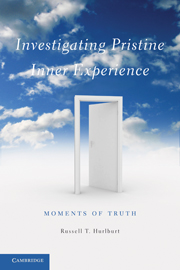Book contents
- Frontmatter
- Contents
- List of Figures and Tables
- Preface
- Acknowledgments
- 1 Moments of Truth
- 2 Fragmented Experience in Bulimia Nervosa
- 3 Apprehending Pristine Experience
- 4 Everyday Experience
- 5 Moments Are Essential
- 6 Experience in Tourette's Syndrome
- 7 The Moment (Not): Happy and Sad
- 8 Subjunctification
- 9 Before and After Experience? Adolescence and Old Age
- 10 Iteration Is Essential
- 11 Epistemological Q/A
- 12 A Consciousness Scientist as DES Subject
- 13 Pristine Experience (Not): Emotion and Schizophrenia
- 14 Multiple Autonomous Experience in a Virtuoso Musician
- 15 Unsymbolized Thinking
- 16 Sensory Awareness
- 17 The Radical Non-subjectivity of Pristine Experience
- 18 Diamonds versus Glass
- 19 Into the Floor: A Right-or-Wrong-Answer Natural Experiment
- 20 The Emergence of Salient Characteristics
- 21 Investigating Pristine Inner Experience
- Appendix: List of Constraints
- References
- Index
17 - The Radical Non-subjectivity of Pristine Experience
Published online by Cambridge University Press: 05 June 2012
- Frontmatter
- Contents
- List of Figures and Tables
- Preface
- Acknowledgments
- 1 Moments of Truth
- 2 Fragmented Experience in Bulimia Nervosa
- 3 Apprehending Pristine Experience
- 4 Everyday Experience
- 5 Moments Are Essential
- 6 Experience in Tourette's Syndrome
- 7 The Moment (Not): Happy and Sad
- 8 Subjunctification
- 9 Before and After Experience? Adolescence and Old Age
- 10 Iteration Is Essential
- 11 Epistemological Q/A
- 12 A Consciousness Scientist as DES Subject
- 13 Pristine Experience (Not): Emotion and Schizophrenia
- 14 Multiple Autonomous Experience in a Virtuoso Musician
- 15 Unsymbolized Thinking
- 16 Sensory Awareness
- 17 The Radical Non-subjectivity of Pristine Experience
- 18 Diamonds versus Glass
- 19 Into the Floor: A Right-or-Wrong-Answer Natural Experiment
- 20 The Emergence of Salient Characteristics
- 21 Investigating Pristine Inner Experience
- Appendix: List of Constraints
- References
- Index
Summary
“Karen” sample 3.1. Karen was studying for her psychology test. At the moment of the beep she was seeing the words “abuse treatment,” which were experienced to be inside her head, toward the front, as if the point of view was in the back of her head and the words were projected in front of her. The words were seen in bubble letter font, all lower case, and had thin black edges as sketched in Figure 17.1. There was no color in this seeing. The letters of “abuse treatment” floated like balloons, each individual letter independently in motion, moving slightly up and down vertically (and not side to side). She also heard herself innerly saying the word “abuse” (not “abuse treatment”) in her own voice, in a normal volume, but in a flat tone. This voice experience was decidedly a hearing experience rather than a speaking experience, as if she were hearing her own voice as played back by a tape recorder. Although she described her voice as being spoken at a normal volume, she said she experienced it as being loud because she was in a quiet computer lab.
Karen's sample 3.1 is a more or less typical datum from a more or less typical DES subject, a twenty-four-year-old college student. This chapter asks whether we should conceptualize such data as bits of Karen's subjective experience or as bits of Karen's objective experience.
- Type
- Chapter
- Information
- Investigating Pristine Inner ExperienceMoments of Truth, pp. 325 - 346Publisher: Cambridge University PressPrint publication year: 2011



